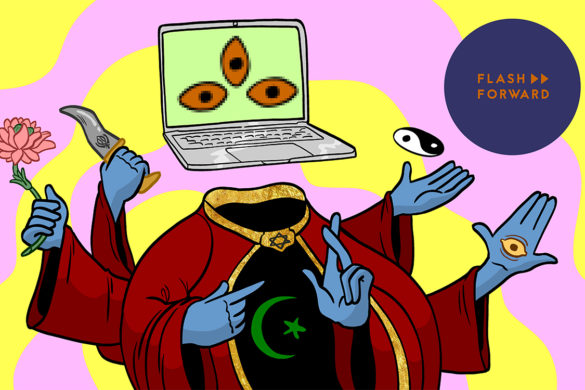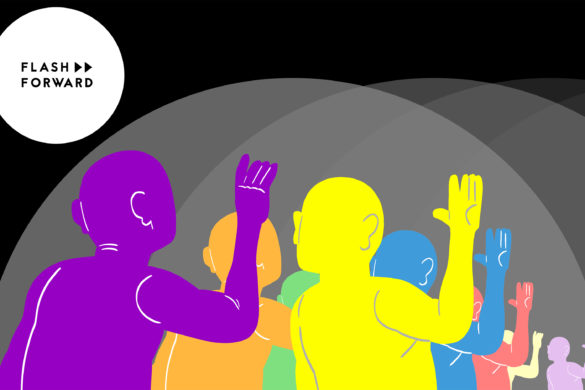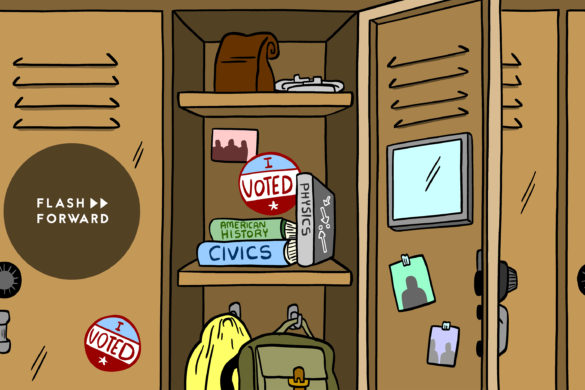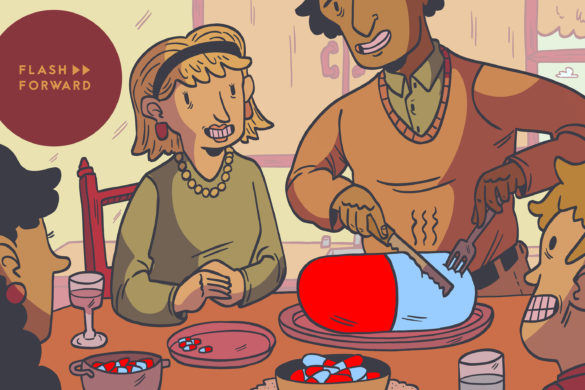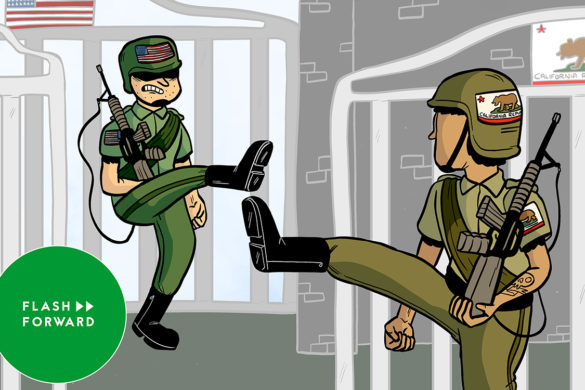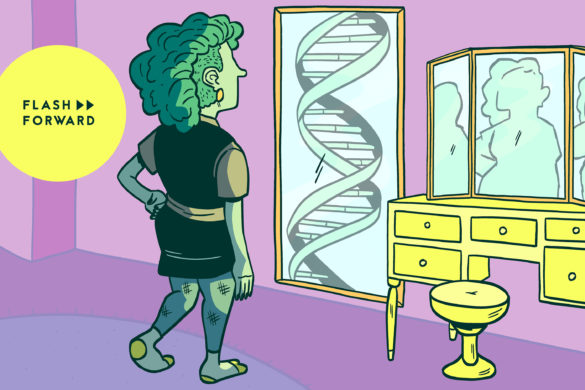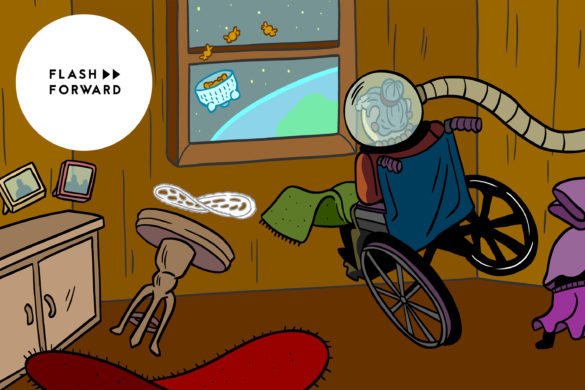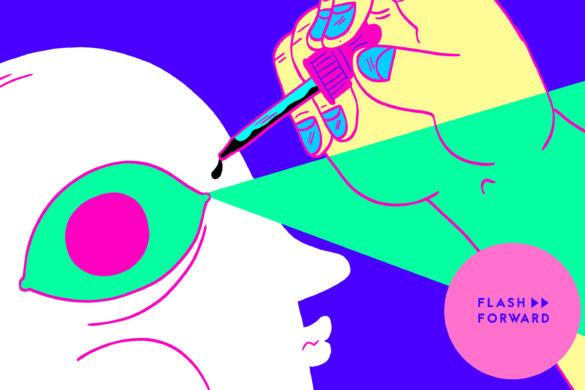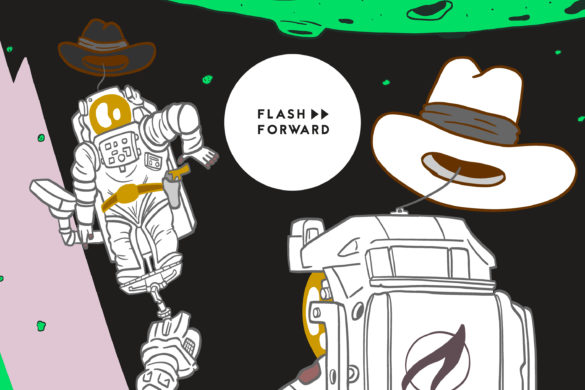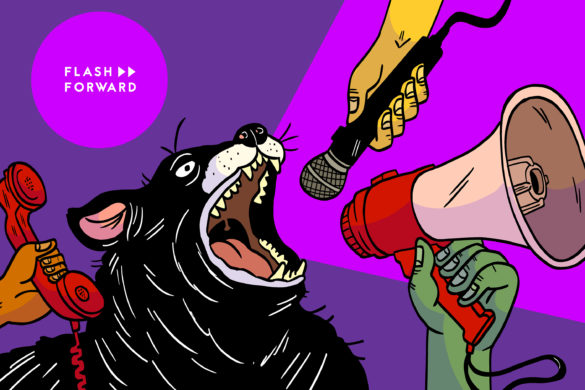Today we travel to a future where fire is completely safe for humans.
Guests:
- John Lentini, a certified fire investigator who has served as an expert witness in over 200 legal cases.
- Dr. Lynn Hulse, a psychologist with the University of Greenwich’s Fire Safety Engineering Group.
- Nisha Baliga, the co-executive director of urban planning nonprofit Hester Street, and Jimena Veloz, a senior project manager at Hester Street.
- Dr. Frank Lake, a research ecologist with the U.S. Forest Service who has family in the Karuk Tribe and the Yurok Tribe.
Further Reading:
- A Brief History of Cooking With Fire
- Fire Safety in the United States Since 1980
- World Fire Statistics
- The Lime Street Fire: Another Perspective
- Arson Suspect Freed After Officials Burn 2nd House
- Forensic Fire Investigations Need More Scientific Input, AAAS Report Finds
- Fire investigation: Historical perspective and recent developments
- Forensic Science Put Jimmy Genrich in Prison for 24 Years. What if It Wasn’t Science?
- Revisiting flexible polyurethane foam flammability in furniture and bedding in the United States
- Chemical industry fights for flame retardants
- Smoke Alarms in US Home Fires
- Risk factors associated with unintentional house fire incidents, injuries and deaths in high-income countries: a systematic review
- The Power & Proximity of Code Enforcement: A Tool for Equitable Neighborhoods
- Do the Poor Pay More for Housing? Exploitation, Profit, and Risk in Rental Markets
- Santa Clarita’s Collaborative Approach Overcomes Code Enforcement Challenges
- A review of the literature on human behaviour in dwelling fires
- Perception and recollection of fire hazards in dwelling fires
- The worst fire season ever. Again.
- Indigenous Fire Stewardship
- The role of indigenous burning in land management
- The USDA Forest Service—The First Century
- To Manage Wildfire, California Looks To What Tribes Have Known All Along
Episode Sponsors:
- Dipsea: An audio app full of short, sexy stories designed to turn you on. Get an extended 30 day free trial when you go to DipseaStories.com/flashforward.
- NordVPN: Get secure and private access to the Internet. Get 74% off NordPass at https://nordpass.com/XXX or use a code XXX. Plus, you get 4 additional months for FREE!
- BetterHelp: Affordable, private online counseling. Anytime, anywhere. Flash Forward listeners: get 10% off your first month at betterhelp.com/flashforward
- Shaker & Spoon: A subscription cocktail service that helps you learn how to make hand-crafted cocktails right at home. Get $20 off your first box at shakerandspoon.com/ffwd.
- Tab for a Cause: A browser extension that lets you raise money for charity while doing your thing online. Whenever you open a new tab, you’ll see a beautiful photo and a small ad. Part of that ad money goes toward a charity of your choice! Join team Advice For And From The future by signing up at tabforacause.org/flashforward.
- Tavour: Tavour is THE app for fans of beer, craft brews, and trying new and exciting labels. You sign up in the app and can choose the beers you’re interested in (including two new ones DAILY) adding to your own personalized crate. Use code: flashforward for $10 off after your first order of $25 or more.
- Purple Carrot: Purple Carrot is THE plant-based subscription meal kit that makes it easy to cook irresistible meals to fuel your body. Each week, choose from an expansive and delicious menu of dinners, lunches, breakfasts, and snacks! Get $30 off your first box by going to www.purplecarrot.comand entering code FLASH at checkout today! Purple Carrot, the easiest way to eat more plants!
Flash Forward is hosted by Rose Eveleth and produced by Julia Llinas Goodman. The intro music is by Asura and the outtro music is by Hussalonia. The episode art is by Mattie Lubchansky.
If you want to suggest a future we should take on, send us a note on Twitter, Facebook or by email at info@flashforwardpod.com. We love hearing your ideas! And if you think you’ve spotted one of the little references I’ve hidden in the episode, email us there too. If you’re right, I’ll send you something cool.
And if you want to support the show, there are a few ways you can do that too! Head to www.flashforwardpod.com/support for more about how to give. But if that’s not in the cards for you, you can head to iTunes and leave us a nice review or just tell your friends about us. Those things really do help.
That’s all for this future, come back next time and we’ll travel to a new one.
FULL TRANSCRIPT BELOW
▹▹ ▹▹ ▹▹ ▹▹ ▹▹ ▹▹ ▹▹ ▹▹ ▹▹ ▹▹ ▹▹ ▹▹ ▹▹ ▹▹ ▹▹ ▹▹ ▹▹ ▹▹ ▹▹ ▹▹ ▹▹ ▹▹ ▹▹
FLASH FORWARD
S7E10 – “Can We Conquer Fire?”
[Flash Forward intro music – “Whispering Through” by Asura, an electronic, rhythm-heavy piece]
ROSE EVELETH:
Hello and welcome to Flash Forward! I’m Rose and I’m your host, recording this special this week from a blanket fort in a rental house. Flash Forward is a show about the future. Every episode we take on a specific possible, or not-so-possible, future scenario. We always start with a little field trip into the future to check out what’s going on, and then we teleport back to today to talk to experts about how that world that we just heard might, or might not, actually happen. Got it? Great!
This episode we’re starting in the year 2047.
FICTION SKETCH BEGINS
ANNOUNCER:
[generic light-mood guitar]
Has this ever happened to you?
You’re trying to light a match… [match strike] but end up burning your fingers!
You’re home from a tough day at work and just want to put on some relaxing candles… but you can’t get the wick to light!
Your space heater singes your carpet… but doesn’t seem to warm up the room!
You need SAFEGLO! The no-heat flame sensation that’s sweeping the nation.
SafeGlo lights instantly. No more struggling with matches or waiting around for your fireplace to kindle. Just instant fire wherever, and whenever you need it.
No need to worry about kids or pets hurting themselves on a hot stove or accidentally getting a hold of your lighter. SafeGlo is cool to the touch and completely safe and non-toxic to humans. It toasts your bread – not your hand.
The possibilities really are endless! SafeGlo is a safe and effective alternative to fireplaces, heaters, stoves, campfires, barbecues, candles, matches, lighters, and more! Available in a range of sizes and colors.
So what are you waiting for? Call now to get your SafeGlo home fire kit and receive a free pocket flame on us. If you don’t LOVE it, just send it back within 30 days for a full refund.
[superfast disclaimer voice] Terms and conditions apply. These statements have not been evaluated by the FDA or any regulatory agency. Do not use SafeGlo if you are pregnant or may become pregnant, or if you have ever been diagnosed with a dust allergy.
[back to regular speed announcer voice] SAFEGLO: A flame just right, at the speed of light!
FICTION SKETCH END
ROSE:
Okay, so today’s episode is special because you are mostly not going to hear from me. Instead, I’m handing this one off to Julia Llinas Goodman, who had a big question they wanted to take on: What’s the deal with fire? Why is it so dangerous, yet so fascinating? And what would happen if we didn’t have to worry about it at all?
JULIA:
For a long time, I’ve had this question about why humans still face so much danger from fire. I mean, it makes sense to me that back when most people were cooking food over an open flame, and heating their homes with fireplaces, and using candles for light, fire would be a pretty big problem.
But things have changed a lot since then. It’s been nearly 150 years since Thomas Edison patented the lightbulb. More than 85% of homes in the US rely on electricity or natural gas for heat, while only about 2% primarily use wood. And we have all kinds of different ways of cooking food – from gas ranges to induction stoves – that seem like they should be a lot safer and less likely to start an out-of-control fire.
And there are way fewer fires than there used to be. In 1980, there were nearly 3 million fires in the US. By 2019, that number had dropped to 1.3 million, which is especially impressive considering how much the population increased over that time. But that’s still kind of a lot of fires and thousands of people still die in them every year.
So why is fire still so dangerous to humans? Would it ever be possible for us to be completely safe from it?
To answer that question, we need to start with a much more basic one: What is fire, exactly? Like, how does it work?
JOHN LENTINI:
It’s an exothermic chemical reaction. That means it gives off heat, and it involves the emission of heat and light in various intensities. Basically, what happens is a fuel, typically carbon-based fuel or hydrocarbon-based fuel, mixes with oxygen from the atmosphere to produce carbon dioxide and water.
JULIA:
This is John Lentini, a certified arson investigator who’s spent decades studying how and why fires start. One of the most surprising things he told me was that solids actually don’t burn.
JOHN:
Everything takes place in the gas phase. So, flammable liquids don’t burn, combustible solids don’t burn. It has to be turned into a vapor in order to burn.
JULIA:
So, say you’re burning a piece of wood.
JOHN:
The fire causes the chemical bonds in the molecules to break, and that releases liquids and vapors, and then the vapors are what actually burns.
JULIA:
In other words, with enough heat and oxygen to react with, the wood will start to break down from a solid into a vapor. And the vapor is actually what catches fire and produces flames.
Okay, so why do some things burn, while others don’t? Like, when you put a metal pan on the stove, it gets really hot, but it doesn’t catch fire. That’s because the atoms in metal are much more tightly bound together than those in wood, so it takes a lot more energy to separate them.
However, metal can burn! It helps if you grind it into a powder first, breaking apart some of the atomic bonds. But even if you manage to grind up your silverware, that still doesn’t mean you’ll be able to light it on fire. (And please, do not try that.)
Fire needs three key components to burn, which is often referred to as the “fire triangle.”
JOHN:
And the triangle consists of fuel, heat, and oxygen. And you’ve got to have all three of those or you’re not going to have a fire.
JULIA:
Wood molecules already contain oxygen, but pure metals don’t. So fireworks, for example, need powdered metal plus additional oxygen sources to ignite.
This also means that our intro scene about fire that burns without heat is… impossible, as far as we know. Heat is one of the key ingredients. And John points out that it would be really hard to get rid of that part of the triangle, anyway. While most people in the world no longer cook over an open flame, they still have heat in the form of stoves, radiators, and electrical devices.
JOHN:
For as long as people are going to cook food, and I don’t see that changing any time soon, you know, we’re going to have cooking fires. As long as the weather is going to be not-a-comfortable temperature, we’re going to need electricity to either heat ourselves or cool ourselves.
JULIA:
And humans, kind of famously, need to spend most of our time around oxygen, so eliminating that piece of the fire triangle is definitely out.
But what if, in order to make fire safer, we focused on fuel? This is actually part of what John studies. Arson investigation is about analyzing a fire to figure out how it started and what exactly burned.
There was this case that really changed the way John thought about fire and fuel. In October of 1990, a house in Jacksonville, Florida burned. Gerald Lewis escaped the fire with his 3-year-old son. But his wife, his pregnant sister-in-law, and the family’s four other children died.
It was a really upsetting event and the case received a lot of public attention. Lewis’s wife had a restraining order against him and there was a record of him threatening to burn the house down. Prosecutors charged him with arson, which, in Florida, meant he was facing the death penalty. Lewis said he didn’t start the fire – that he didn’t even know how it started.
JOHN:
He said that he saw a basketball-sized fire on a sofa, and he and his wife had tried to put it out, and it got away from them.
But we just couldn’t believe it would burn that quickly.
JULIA:
The speed of the fire suggested someone had added an accelerant, like gasoline. A bottle of gas was found in Lewis’s car and the prosecutor’s analysis also detected gasoline. 12 different fire investigators said this was arson. But then, they brought in John.
JOHN:
And when I looked at this guy’s chemical analysis, it was crap. It was not gasoline. And I took the data and had it copied and sent around the country to, you know, 10 of the top people in the fire debris analysis world, and they all said, “This is not gasoline,” doesn’t look anything like gasoline.
JULIA:
But a lot of other clues did support the idea of an arson. Like the cracks in the glass were in this pattern that’s called spider webbing, or crazed glass.
JOHN:
Crazed glass, that meant rapid heating, which in turn means it’s an intentionally set fire.
JULIA:
The way the wood had burned also looked like a hotter, intentional fire.
JOHN:
What looked like the scales on an alligator’s back, we call it alligatoring. And if the scales were big and shiny, that meant a rapid fire. And if they were flat and dull that meant a slow fire.
JULIA:
The evidence was unclear. But as luck would have it, there was an identical house on the same block. It had been condemned and was about to be demolished anyway. So the team decided that instead, they would burn the house down, imitating an accidental fire like the story Lewis told. If the fires looked the same, it would prove that Lewis could be telling the truth.
John and his colleagues went to really extreme lengths to make sure the conditions were the same in both fires. They figured out where Lewis’s family had bought their furniture and bought the exact same furniture for the experimental house. They redid the floors, the walls, the curtains to be as similar as possible.
When everything was ready, the team lit the couch on fire. And they waited to see when the room would become “fully involved,” which means the entire room is on fire.
JOHN:
And we thought for sure it was going to take 15 or 20 minutes for the room to get fully involved. And by the time three-and-a-half minutes had passed, the room was fully involved.
JULIA:
Even though there was no gasoline, just a regular couch, the fire burned super fast and hot. Suddenly, Lewis’s story made sense.
JOHN:
I was ready to go and render an opinion that the fire had been intentionally set, until I ran the test. And the prosecutor was right there with me, I was working for him, and I said, “I don’t think I can go and give that testimony tomorrow like we talked about.” I was going to participate in sending this guy to the electric chair based on, you know, what I thought I knew about fires.
JULIA:
It turns out, a lot of the indicators that people use to prove an arson, aren’t perfect.
JOHN:
Not only are they not perfect, they’re not good indicators at all. But people believed them for years and years because the people practicing fire investigation were not scientifically trained.
JULIA:
This was a really big deal, and not just for John personally. His experimental findings challenged some of the most basic rules of arson investigation. Prosecutors dropped the case against Lewis, but some of John’s colleagues weren’t so quick to let the whole thing go.
JOHN:
I was a pariah in the fire investigation world for a number of years. They called me everything but a child of God for letting a killer go.
JULIA:
This kind of thing is a problem across forensic science. A lot of forensics comes out of police work – not scientific research. And that means sometimes the standards aren’t nearly as rigorous.
But a lot of people on juries, and even forensic researchers themselves, believe the field is much more reliable than it actually is. Some bitemark examiners have claimed they would only make an incorrect identification one in 10 quadrillion times. When actually tested, they were found to be wrong about one in six times.
Research has found that faulty forensic work is a factor in a quarter to half of all wrongful convictions. And those are just the ones we know about – the people who were eventually able to be exonerated.
JOHN:
I have helped no fewer than 15 people get released from the penitentiary after they have been convicted of arson. And getting a conviction overturned is really, really difficult. And it can take years, if not decades, to make it happen. Because although you are innocent until proven guilty, once you are proved guilty, one time, it becomes your burden. You’re guilty until you can prove yourself innocent, which is very difficult, if not impossible. So yeah, there’s still people rotting in prison that don’t belong there.
JULIA:
John had an interesting theory about why so many people get convicted of arson, even though most fires are accidents.
JOHN:
If you have a death, particularly if children die, somebody’s got to pay the price. Whether anybody did anything wrong or not, somebody’s got to pay the price. And fire is just… you know, it makes the evening news and it gets people, you know, all frothed up about bringing justice to the poor victims. I see this so many times. People talk about, “We’ve got to bring justice to the victims.” Well, if the victim is a victim of an accident, then there’s no justice to be had. But you know, sometimes people want to bring it anyways.
John’s test fire in Gerald Lewis’s case showed that a really bad fire could happen, even if no one did anything wrong. The fuel was just a regular living room sofa and it burned way faster than arson investigators thought was possible. So, why was that?
JOHN:
These days, our furnishings are filled with polyurethane foam, which is, like, solid gasoline. It’s even got the air mixed into it with the foam plastic.
JULIA:
Okay, so that really surprised me. Like, why are we making couches out of solid gasoline?
JOHN:
People just didn’t have a clue what they were doing when they put polyurethane foam into sofa cushions. So, certainly we can improve the materials that we surround ourselves with.
JULIA:
In the 1950s and ‘60s, synthetic fabrics started to show up everywhere. They were cheap, versatile, and easy to take care of, and they were unsurprisingly popular.
But it also quickly became clear that many synthetic materials were dangerously flammable. California enacted one of the earliest furniture fire safety standards in 1975.
JOHN:
They’ve now got standards for mattresses and furniture where, you know, it can burn, but it can’t burn too hot. And so that just reduces the danger of it; makes it a whole lot easier for someone to extinguish early on.
JULIA:
Unfortunately, the major chemical companies producing synthetic fabrics didn’t stop selling them. Instead, they added a bunch of new chemicals, called flame retardants, that were supposed to make synthetic materials safer.
JOHN:
It just turns out that those chemicals are so nasty they’ll give you cancer. So you want to die from a fire? Or you want to die from cancer from exposure to these nasty chemicals?
JULIA:
Here’s the kicker: these chemicals don’t even prevent fire very well. Fires that start with upholstered furniture still account for one-fifth of fire deaths in the U.S.
And in the last several years, lawmakers have been trying to regulate flame retardants. But the American Chemistry Council – whose members include Chevron, Dow Chemical, and Dupont – has been fighting tooth and nail to keep these chemicals around.
Chemical companies have an interest in using flame retardants so that they don’t have to come up with another solution to the whole “sofa-made-of-solid-gasoline” problem. But tackling this problem, in a real way, could get us closer to a future where fire isn’t such a threat.
And John did have some other ideas for how we could make ourselves completely safe from fire. He said focusing on fire detection could be the best way to do that.
JOHN:
It is possible that we could develop fire detection capabilities that would allow us to detect fires before they get big enough to do any damage or hurt anybody. The existing technology today could just be improved, miniaturized, made cheaper, so that you could put half a dozen detectors in a room. One that will detect carbon dioxide going up, one that will detect temperature going up, one that will detect smoke, one that will detect light.
JULIA:
This is actually a huge part of why there are fewer house fires today than there used to be.
JOHN:
The number of fire deaths in the United States is going down. It’s been going down ever since smoke alarms got cheap, and they continue to go down. And usually what we find when you have a fatality is that the building wasn’t sufficiently protected with smoke alarms.
JULIA:
Keeping a working smoke alarm at home cuts the risk of dying in a fire in half. But unfortunately, that’s not something everyone has.
JIMENA VELOZ:
It’s so tied to, like, housing justice and tenants’ rights. What are the rights of a tenant? What are the responsibilities of a landlord? And when those aren’t met, how does the city intervene to make landlords, you know, do what they’re responsible for?
And we’re going to talk more about that when we come back.
ADVERTISEMENT: NORDVPN
Today’s episode is sponsored in part by NordVPN.
We talk about privacy, and security, and data, and surveillance a lot on this show, and I am kind of constantly the person that my friends text for advice on how to be more secure in their day-to-day technological dealings. And there are all kinds of tips and tricks out there, but one easy way to make yourself a little bit harder to track is by using a VPN.
What is a VPN? VPN stands for Virtual Private Network and it masks your IP address, which is one of the ways that advertisers and companies identify and track you around the web. I especially recommend VPNs for folks who might travel a lot and wind up having to connect to public wifi, or hotel wifi, or conference wifi and you really have no idea if those networks are secure or not.
So if you now are like, “Okay, cool. I want one of these VPN things.” Check out NordVPN. NordVPN lets you connect up to six devices at once. They have an iPhone and Android app. They have superfast servers, and it comes with something called CyberSec suite, which acts as an ad blocker, which is also great.
They are currently having a huge summer sale for listeners. You can get 74% off NordPass at NordPass.com/FlashForward. Plus, on top of that 74% off, you get four additional months for free. Go to NordPass.com/FlashForward. And if you want to find out about NordVPN, you can go to NordVPN.com.
ADVERTISEMENT END
ADVERTISEMENT: DIPSEA
Today’s episode is sponsored in part by Dipsea.
Dipsea is an audio app full of short, sexy stories designed to turn you on. Whether you’re looking for boy-meets-girl, girl-meets-girl, they-meets-they, or any combination of those things, and more, Dipsea has you covered. Or… uncovered, I guess? (Haha, sex joke!)
If you can’t tell, sexy is not really a part of my personal brand, but I’m doing the best I can here. (laughs) I really do appreciate that Dipsea’s audio stories feature characters that feel like real people and immersive scenarios so you feel like you’re right there.
You can listen to stories about hooking up with your hometown crush that you never made a move on, or that co-worker that you always had a little thing for. They release new content every week, so there is always more to explore no matter who you’re into or what turns you on. And if you just need to wind down, Dipsea also has wellness sessions, sensual bedtime stories, and soundscapes to help you relax before you drift off.
For listeners of Flash Forward, Dipsea is offering an extended 30-day free trial when you go to DipseaStories.com/FlashForward. That is 30 days of full access for free when you go to DipseaStories.com/FlashForward.
ADVERTISEMENT END
JULIA:
So, remember how earlier I mentioned that the number of fires in the US has decreased over time? That’s true, but it’s also not the whole story.
While the likelihood of a fire happening has gone way down in the last 40 years, the odds of someone dying or being injured when one does happen, have actually increased. In other words, the total number of fire deaths has gone down. But the proportion of fire deaths has gone up.
DR. LYNN HULSE:
Ensuring that we have fire detection, early warning systems such as smoke alarms, all that’s really helped and brought down the number of fires that occur. But we still see that the amount of harm that occurs when one does break out is really not changing that much, or in recent years is actually increasing. So I think it’s probably an easier task to try and stop fires from occurring than it is to stop fire deaths and fire injuries.
JULIA:
This is Dr. Lynn Hulse, a psychologist with the University of Greenwich’s Fire Safety Engineering Group.
And this is a particular problem with residential fires. While only about a quarter of all US fires happen in someone’s home, those fires account for nearly 80% of deaths. This risk doesn’t impact everyone equally. Research consistently finds that low-income people are more likely to be injured in fires. And Black and Indigenous folks are disproportionately likely to lose their lives in a fire.
A lot of the standards for fire safety, like sprinklers and smoke alarms, are enforced through local building codes. But this process is rooted in a history of racist housing policy.
NISHA BALIGA:
You could basically overlay maps of redlined areas. That would give you the heat map, really, essentially, of properties that would have multiple code violations, or foreclosure, or things like that.
JULIA:
This is Nisha Baliga, the Co-executive Director of a nonprofit called Hester Street.
NISHA:
We’re an urban planning, design, and development nonprofit that works to ensure that neighborhoods are shaped by the people who live in them.
JULIA:
In 2018, Hester Street started working to identify specific parts of the code enforcement process that could disproportionately harm low-income people and people of color.
JIMENA:
People rent a room in a home and, like, sometimes those rooms don’t have windows, right? And that is a fire hazard. So when a code enforcement officer comes to their home, the house might be condemned; there might be code violations. And it is in the interest of keeping them safe, but at the same time, what happens is that… When housing is in bad condition, when landlords are doing not-so-great practices, what happens is that people end up without a home.
JULIA:
This is Jimena Veloz, a Senior Project Manager at Hester Street.
One issue is that landlords are more likely to neglect the homes of low-income tenants. Residents below the poverty line are less likely to have functioning smoke alarms, for example.
JIMENA:
In lower-income neighborhoods, landlords tend to invest less. And that sometimes is around things that will make a home safer around fire, but also around, you know, health.
JULIA:
In fact, paying a fine tends to be cheaper than fixing the problem.
JIMENA:
They might get a code violation, for example, pay the code violation, but not repair the issue. So it’s sometimes part of the business model, and that impacts the lives of residents.
JULIA:
And sometimes, even homeowners can’t afford to make repairs.
JIMENA:
Low-income communities, communities of color, have a harder time getting loans to improve their homes. So they see a higher rate of code violations because sometimes they just don’t have access to the money to make their property safe and healthy.
JULIA:
Often, low-income communities of color don’t get the support they need from city agencies.
JIMENA:
They sometimes get to properties when it’s too late, when the only solution could be to condemn the property and make sure no one can live there, or demolish a place. And what we think of as equitable enforcement is, on one side, to be proactive and make sure that properties don’t get to a place where they’re, like, falling down or really unsafe and you have to make people leave.
JULIA:
Neighborhoods where more people of color live can also receive more negative attention from code enforcement. Some rules are subjective, leaving city officials to decide on a case-by-case basis if a situation is unsafe or unhealthy.
NISHA:
For example, a lot of violations in some cities are about the number of people living in a certain size unit, or a unit that might have, you know, one bedroom and you have like five people. And you know, I think that is something that, depending on cultural norms, depending on your economic situation… We talked a lot about it. It’s derived from the belief that a suburban model of a three-bedroom house for a family of four is what’s safe and healthy.
JULIA:
When cities respond to situations like this with an eviction or foreclosure, it doesn’t mean that families will move on to a better situation. They might just end up with another landlord who doesn’t make repairs or safety changes, and the cycle continues.
But there are ways cities can support their residents to have safer homes, rather than punishing them for problems they can’t solve by themselves.
Like this program that started in 2008 in Santa Clarita, California. The city made a list of all the code violations, but they didn’t start out by giving residents a fine. Instead, they notified people of the issue and connected them with resources to help pay for the repairs.
NISHA:
So, could you get a bulk discount at Home Depot to take care of this? Could you get a vendor to help with roofs? Could you do, like, community projects in the neighborhood where you can help each other take care of your violations? And then they also provided mini-grants for people to take care of that. And it kind of became a whole thing where we’re like, “We’re going to help you get this because our end goal is not to give you a ticket and get you out of your house. Our end goal is to keep you safe, keep you in this neighborhood, and have this neighborhood thrive.”
JULIA:
At the end of the experiment, 95% of homes that participated had gotten up to code. And this is the kind of thing we have to think about if we want a future where we’re totally safe from fire.
JIMENA:
You’ve heard this phrase of, like, “Well, you know, the day after the revolution happens, someone still has to pick up the trash.” I think I think it’s similar, right? After everyone has safe housing, buildings will still have leaks, and there might still be pests, and they will still need maintenance. So how do we invest so that a building’s decay doesn’t affect residents and doesn’t put residents at a disadvantage?
JULIA:
There’s another piece to the home fire safety issue. One that’s less about detection and prevention and more about what people do after a fire breaks out.
LYNN:
Fire services will usually have short statements, something along the lines of, “Get out, Call (in the USA) 911, and stay out.” Usually, that doesn’t happen.
JULIA:
That’s Dr. Lynn Hulse again. And to be clear, if there’s a fire in your house, you should get out.
But Lynn says the situation is a little more complicated than that. Because when there’s a house fire, it doesn’t matter that people are told to leave and call for help right away. Most of them don’t. In fact, in an estimated 60-80% of home fires, people don’t call the fire department at all. Instead, they try to handle it themselves.
LYNN:
And then we also see quite a substantial number of people trying to reenter buildings before they’ve been told it’s safe, or before the fire service have got there to secure it.
JULIA:
Lynn worked on this one study that showed people clips of different sized kitchen fires. The videos lasted for just a couple of seconds because they wanted to get people’s immediate reaction – the time they might have in an actual emergency.
LYNN:
We asked them if they would enter the room with the smoke or if they would attempt to tackle the flames. And we saw quite a large number of people saying yes to that, or at least saying “We’re not sure”.
JULIA:
Even for the largest fire, where the flames spread up the wall and reached all the way around to the ceiling, about a third of people said they thought they could safely put it out by themselves.
This was just one study, but it seems to support the evidence about how people behave in a real fire. Lynn says maybe we need to start accounting for that in the way we teach fire safety.
LYNN:
I think there has to be a compromise between what civilians want to do and what the emergency services want them to do. Again, the messaging has been very much just telling people, “Get out and leave it to the professionals.” And we would like to see more people get out if it is a larger fire, obviously. If it’s beyond their capability, they shouldn’t be trying to tackle it.
But perhaps the emergency services and the industry of fire safety could accept more that people will try and tackle it first themselves and therefore give them the training to help them not only handle fire protection equipment, such as fire extinguishers or fire blankets, but also help them recognize what is a fire that is possible for you to tackle and what is one that is most likely to be beyond your capabilities so don’t even try.
JULIA (on call):
This might be a funny comparison, but it kind of reminds me of, like, abstinence-only sex education. Like, you shouldn’t tell people just don’t do it at all; you should help them figure out how to respond safely.
LYNN:
Exactly, yeah.
JULIA:
This isn’t the only way that we might need to rethink fire education. Especially when it comes to wildfires.
DR. FRANK LAKE:
How many people grow up with Bambi, and Smokey the Bear, and all these negative things that teach you to fear fire and that fire is bad? What if you had just the opposite training and teaching that this is how fire is good for the fish, good for the water, good for the wildlife, good for those plants?
JULIA:
And that’s what we’re going to talk about when we come back.
ADVERTISEMENT: BETTERHELP
Today’s episode is sponsored in part by BetterHelp.
I don’t know about you, but I feel like we’ve collectively unlocked some new stage in this, like, dystopian pandemic video game it feels like we’re playing? We still have, you know, the pandemic that is still killing people, and now people are taking drugs that destroy their intestinal lining that are made for horses instead of getting vaccinated. Plus, it is hurricane and fire season. Plus the terrifying conflicts and human rights abuses escalating in places like Afghanistan, Palestine, Lebanon… the list goes on.
So I don’t know, maybe you feel like there is something interfering with your happiness or is preventing you from achieving your goals. (That’s the copy that BetterHelp always gives to me and sometimes I’m like, [sarcastic] “Yeah, I don’t know, maybe. Something. Who can say that what something might be?”)
Joking is a coping mechanism, but a better coping mechanism is actually talking to a professional therapist. And if you are really feeling a certain way about all of this, or really about anything, it genuinely is worth considering finding a therapist, and BetterHelp is a great place to start.
BetterHelp will assess your needs and match you with your own licensed professional therapist who you can start communicating with in under 48 hours. It’s not a crisis line; it’s not self-help. It is professional therapy done securely online. You can log into your account anytime and send a message to your therapist, and you’ll get timely and thoughtful responses. Plus, you can schedule weekly video or phone sessions so you don’t have to sit in a therapy waiting room ever again.
BetterHelp is also committed to facilitating great therapeutic matches, so they make it easy and free to change therapists if you need. Visit BetterHelp.com/FlashForward and join the over two million people who have taken charge of their mental health with the help of an experienced professional. And there is a special offer for Flash Forward listeners. Get 10% off your first month at BetterHelp.com/FlashForward.
ADVERTISEMENT END
JULIA:
Okay, we’ve talked a lot so far about structure fires, the ones that happen in our homes, workplaces, and other buildings. But while structure fires have gotten way less common over the last few decades, wildfires are becoming larger and more intense.
Between the 1970s and 2015, the US Forest Service estimates that wildfire season got at least two-and-a-half months longer. And if you live in a place like the western United States or New South Wales in Australia, you’ve probably noticed this. It’s fueled partly by climate change.
FRANK:
We see an extreme variability that’s increasing towards the more extreme ends of drying, and wind, and heat waves that really are unprecedented.
JULIA:
This is Dr. Frank Lake, a Research Ecologist with the US Forest Service.
FRANK:
I’m a Karuk descendent of the tribe here in northwest California.So, I’m an interesting individual in the nexus that I have a PhD in Environmental Science with an ecology emphasis, so I’m Western academically trained. And then I have the traditional teachings and upbringing of my native culture.
JULIA:
And climate change is definitely making wildfires more extreme.
FRANK:
So we always know that there’s trends towards, when it gets warmer and drier climatically, that you have more fire potential.
JULIA:
But that’s not the only problem. The way humans interact with fire has also changed significantly over the last couple of centuries. For thousands of years before European colonization of the Americas, Indigenous communities lived in the Western United States.
FRANK:
And through that time, people learned and adapted to their environment, learned how to live in place.
JULIA:
One of the important parts of that environment was fire. And that could be dangerous, but it could also be useful. Frank refers to these Indigenous communities as ‘fire-dependent cultures’ because they actually needed fire to support the plants they used for food, medicine, and tools.
Take huckleberry bushes, for example.
FRANK:
If its forest grows in too much over those berries, as an understory plant, and the forest canopy gets too closed, then it has too much shade and not enough light. You have vegetative growth, just leaves and branches of the huckleberries, but they don’t have enough flowering.
JULIA:
So, plenty of bushes; not many berries. But when some of those bigger trees in the forest burn, it makes room for the bushes to get more sunlight so huckleberries can grow.
FRANK:
And you have easier fruit picking. Wildlife has easier access. There’s good vitamins now in the landscape that otherwise would have been shaded out and just been sticks and leaves.
JULIA:
Over time, people learned how these burn patterns worked. And they were able to strategically set fires to change the environment.
FRANK:
So, just not relying upon lightning fire to do what you wanted on the landscape for beneficial fire effects, but to proactively manipulate or modify that fire regime to get the cultural outcomes you want for those fires and the types of things you rely upon that come after fire.
JULIA:
All of that changed when Europeans started taking control of land in the Americas. They tried as hard as possible to stop Indigenous folks from lighting fires. Like when Spanish soldiers arrived in what’s now California.
FRANK:
One of the first rules that went into place by the governor was to suppress Indian burning. California came into statehood soon after that; adopted the same thing.
JULIA:
Part of this was because Europeans hadn’t lived in this ecosystem before and they didn’t know how it worked.
FRANK:
And a lot of that was misunderstanding, I think. You know, from one culture imposing its will and its desires for the land over another, like the Indigenous people, and then that European-based perspective that fire was dangerous or demonizing it, and that there was nothing really good that could come from it. And so you had these really conflicting cultural perspectives about the important role of fire.
JULIA:
And it probably won’t surprise you to hear that these policies were also tied to racism. The attempt to suppress fires was part of a broader strategy to remove Indigenous people from the land.
FRANK:
A lot of the areas that Americans and other colonists settled in were Indian villages that, because of disease were abandoned, because of forced removal were then open for homesteading and for claim. And those areas were open and plowable land. There were large, big trees for timber. And part of the American narrative at that time, and Spanish narrative, was that these were wild, savage, heathen Indians who just wandered the landscape, who didn’t manipulate their environment.
JULIA:
But that wasn’t true at all. The land was open, and lush, and nice to live in because it had been carefully cultivated over thousands of years.
FRANK:
And they also wanted to minimize the acknowledgment or recognition of Native people as being stewards and caretaking that. So then they could capitalize on those resources as part of their own security and interest.
And I also think, you know, there was an association between Indian burning and that that was counter to the interests of the colonial settlers, right? So you demonize both of them, you remove both of them from the landscape. You say both of them have no good benefit here, Indian people and the fire. And then it changes the narrative and people’s outlook on it.
JULIA:
European colonists’ fear of fire was closely linked to their fear of the Indigenous people they were tyrannizing.
FRANK:
Often you see that the negativity directed towards Indian people, who were… “Oh, they’re burning in defiance against us,” or “the Indians are attacking us and burning out places.”
And some of those accounts were, “We were pursuing the Indians across this ridge system as they headed back to the mountains and then they were soon burning off the hills to obscure where we saw them,” or “They were burning out areas to prevent us from tracking them.” And I look at that same time of the year in the fall, and I thought, “Well, that’s very presumptuous.” They probably were burning for acorns and probably burning for pasture and game improvement, and you’re just imposing or interjecting your cultural bias in a negative way about why the Indians were using fire. Or it might have been because they don’t want to be shot and killed by you. They probably were maybe burning out behind to keep you from getting them.
JULIA:
After the founding of the United States, this colonial strategy of fire suppression became official federal policy. Over the 1800s and early 1900s, there was a series of huge, deadly fires. So when the US Forest Service was founded in 1905, one of its first jobs was to try to put out every single wildfire.
The Forest Service’s approach had benefits. They started a fire research program and kept track of where wildfires were happening. Federal rangers were able to warn communities if a fire was headed their way. But there were also a lot of downsides. Suppressing smaller, less dangerous fires meant that forests got denser so that when fires did break out, they were bigger and more intense.
FRANK:
Trees that used to be burned off as seedlings don’t have fire now for 40, 50, 80, 100 years. They grow in; now they’re very large trees that are growing through that matrix of that former more open stuff.
And so now when you have fires that start, because of the removal of that fire that hasn’t cleared out and removed that, you’re having more intense and extensive fires.
JULIA:
Denser forests also lead to drought because there are more trees drawing water out of the ground.
FRANK:
And then you have a change in that forest of a bunch of thirsty vegetation that, when they don’t get enough water, they die and they become now a fuel. And that feeds into the next fire if and when they burn.
JULIA:
And that’s where we are today. Trapped in this vicious cycle that builds on itself, leading to bigger and bigger fires. Climate change is a part of it, but it’s also about the whole way we, as humans, interact with fire.
And this has had particularly devastating impacts for Indigenous, fire-dependent cultures.
FRANK:
With fire exclusion, the forests have got denser. Those areas that they used to be able to gather in no longer have the quality of resources there. And that’s really impacting them, and their food security, and their ability to perpetuate their culture that is linked to fire.
JULIA:
For Frank, having a safe relationship with fire doesn’t mean that humans completely control it. It means that we respect it and learn to live with it.
FRANK:
What would it be like if our whole society was a fire-dependent culture? And when we saw wildfire or we saw a fire used on our terms, we just didn’t see it as something that was catastrophic, that was deadly, that was harmful, that was bad? But we saw it as a system of renewal, as something that’s going to benefit us, as something that we can revere but also have a little bit of healthy fear over?
JULIA:
And that actually means spending more time with fire, not less.
FRANK:
Modern humanity has really separated itself and tries to have all these other things like air conditioning, the built infrastructure, harnessing the power of fuel into a different form of energy than actually feeling the heat and having combustible material.
But if you were actively gathering fuel, that’s what tribes did, and many of them still do in places, we rely upon wood heat for cooking, food preservation, ceremonies. That is fire material that won’t burn in the next fire because you’ve gathered it and had it in a more predictable, desired, contained aspect use of burning it.
JULIA:
In the last few decades, as wildfires have gotten more and more catastrophic, Western forest management has started to recognize the need to try something different. And part of Frank’s work is bringing together the Forest Service’s resources with Indigenous knowledge of the environment.
FRANK:
I don’t want to overinflate or, kind of, overstate that Indigenous people, as fire-dependent cultures, are going to provide all the answers and solutions. But where they haven’t been considered has been a shortcoming of our approach to learn to live with fire. And where it has been considered, and it actually has been adopted, and there’s partnerships and alliances working with Indigenous people to restore fire as part of the environment, as a part of a cultural practice… The science and the feeling in my heart and my mind is that we’re going to be better for it, that we’re going to leave and create a world for our future generations where they can live safer in, and around, and with fire.
JULIA:
When Frank imagines the future of fire, he pictures his grandchildren telling a story. It starts thousands of years ago with Indigenous communities developing a respectful relationship with fire. Then the story shifts to when European colonists arrived and began suppressing fires.
FRANK:
And at the end of that, we saw that the land was sick, people were sick, we were losing our valued animals, our plants, our streams were going dry, our fish were beginning to suffer. And we had a hard place in our relationship of where we’re going to be; who are we going to be as a society? And at that time, these cultures came together, the ones who were the colonist settlers, and the ones that were Indigenous, and there was a way of learning how to live with fire. And these people who tried to suppress and demonize fire for over 100 years learned that maybe they needed a better way to look at it and live with it. And when they began to embrace those teachings,then they came to a place where they had a safer, more livable landscape.
And that would be the story that I would want my grandchildren to say in the future, that we learned from our mistakes. We came together. People used to fear fire. It used to be deadly. But now that we use it and we live with it, we’re in a much better place.
[Flash Forward closing music begins – a snapping, synthy piece]
Flash Forward is hosted by me, Rose Eveleth, and today’s episode was hosted and produced by Julia Llinas Goodman. The intro music is by Asura and the outro music is by Hussalonia. The episode art is by Mattie Lubchansky. Special thanks this week to Andrew Kieve and Marlon Molina.
Two quick, cool things to go along with this episode. We are commissioning some really cool, retro fire posters from an amazing artist. Those are going to be on the website soon and you’ll be able to see them. Patrons are actually going to get some of these in the mail as postcards.
And speaking of Patrons, the book club book for, not next month but the month after, for October, is actually going to talk a lot about some of the stuff we talked about today. It’s called An Indigenous Peoples’ History of the United States and it is, in part, a little bit about some of this fire stuff. So if you’re interested in learning more and you want to become a patron and discuss, we’re going to read all about it in the book club. You can find out more about all of that at FlashForwardPod.com/Support.
If you want to suggest a future that we should take on, send us a note on Twitter, Facebook, or by email at Info@FlashForwardPod.com. We really do love hearing your ideas. And if you want to discuss this episode, some other episode, or just the future in general, you can join the Facebook group! Just search ‘Flash Forward Podcast’ and ask to join.
That’s all for this future. Come back next time and we’ll travel to a new one.
[music fades out]


